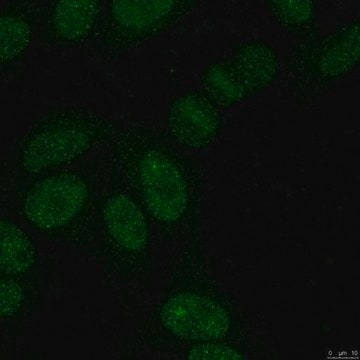MABS2071
Anti-SUMO-1 Antibody, clone 21C7
clone 21C7, from mouse
Synonym(e):
Small ubiquitin-related modifier 1, GAP-modifying protein 1, GMP1, SMT3 homolog 3, Sentrin, Ubiquitin-homology domain protein PIC1, Ubiquitin-like protein SMT3C, Smt3C, Ubiquitin-like protein UBL1
About This Item
Empfohlene Produkte
Biologische Quelle
mouse
Antikörperform
purified immunoglobulin
Antikörper-Produkttyp
primary antibodies
Klon
21C7, monoclonal
Speziesreaktivität
chicken, human, mouse, zebrafish, rat, Xenopus, fish
Verpackung
antibody small pack of 25 μg
Methode(n)
immunocytochemistry: suitable
immunofluorescence: suitable
immunohistochemistry: suitable
immunoprecipitation (IP): suitable
western blot: suitable
Isotyp
IgG2b
NCBI-Hinterlegungsnummer
UniProt-Hinterlegungsnummer
Posttranslationale Modifikation Target
unmodified
Angaben zum Gen
human ... SUMO1(7341)
Allgemeine Beschreibung
Spezifität
Immunogen
Anwendung
Zelluläre Signaltransduktion
Immunocytochemistry Analysis: A representative lot detected SUMO-1 in Immunocytochemistry applications (Matunis, M.J., et. al. (1996). J Cell Biol. 135(6 Pt 1):1457-70; Zhang, X.D., et. al. (2008). Mol Cell. 29(6):729-41).
Immunoprecipitation Analysis: A representative lot immunopprecipitated SUMO-1 in Immunoprecipitation applications (Costa, M.W., et. al. (2011). PLoA One. 6(9):e24812; Becker, J., et. al. (2013). Nat Struct Mol Biol. 20(4):525-31; Girach, F., et. al. (2013). Cell Rep. 5(5):1294-301; Chanda, A., et. al. (2017). PLoS One. 12(5):e0177639).
Western Blotting Analysis: A representative lot detected SUMO-1 in Western Blotting applications (Zhang, X.D., et. al. (2008). Mol Cell. 29(6):729-41; Matunis, M.J., et. al. (1996). J Cell Biol. 135(6 Pt 1):1457-70; Rogers, R.S., et. al. (2004). Chromosoma. 113(5):233-43; Costa, M.W., et. al. (2011). PLoA One. 6(9):e24812; Becker, J., et. al. (2013). Nat Struct Mol Biol. 20(4):525-31).
Immunofluorescence Analysis: A representative lot detected SUMO-1 in Immunofluorescence applications (Girach, F., et. al. (2013). Cell Rep. 5(5):1294-301; Rogers, R.S., et. al. (2004). Chromosoma. 113(5):233-43; Matunis, M.J., et. al. (1996). J Cell Biol. 135(6 Pt 1):1457-70).
Qualität
Western Blotting Analysis: 4 µg/mL of this antibody detected SUMO-1 in HCT116 cell lysate.
Zielbeschreibung
Physikalische Form
Lagerung und Haltbarkeit
Sonstige Hinweise
Haftungsausschluss
Sie haben nicht das passende Produkt gefunden?
Probieren Sie unser Produkt-Auswahlhilfe. aus.
Analysenzertifikate (COA)
Suchen Sie nach Analysenzertifikate (COA), indem Sie die Lot-/Chargennummer des Produkts eingeben. Lot- und Chargennummern sind auf dem Produktetikett hinter den Wörtern ‘Lot’ oder ‘Batch’ (Lot oder Charge) zu finden.
Besitzen Sie dieses Produkt bereits?
In der Dokumentenbibliothek finden Sie die Dokumentation zu den Produkten, die Sie kürzlich erworben haben.
Unser Team von Wissenschaftlern verfügt über Erfahrung in allen Forschungsbereichen einschließlich Life Science, Materialwissenschaften, chemischer Synthese, Chromatographie, Analytik und vielen mehr..
Setzen Sie sich mit dem technischen Dienst in Verbindung.








